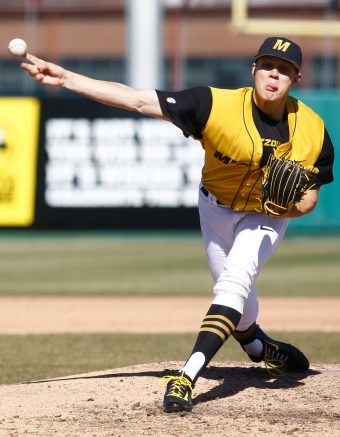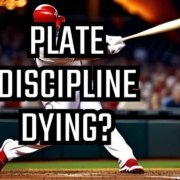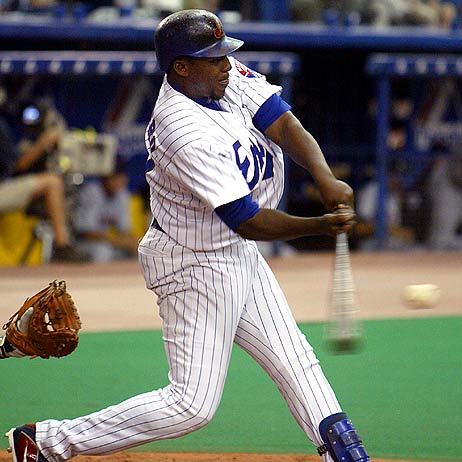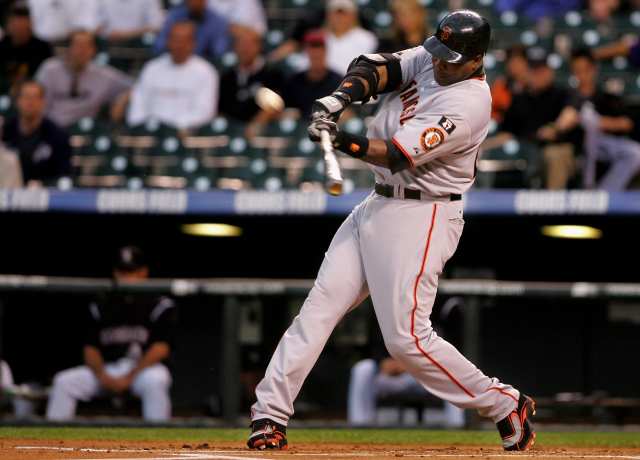Is your son or daughter hitting well practicing in the batting cage, but wondering why they’re struggling at the plate? Do they seem to suffer from a baseball or softball mental block slump? Discover how to make adjustments and simulate game like LIVE pitching!
Baseball Batting Cages: How To Transition Practice Into Game Swings
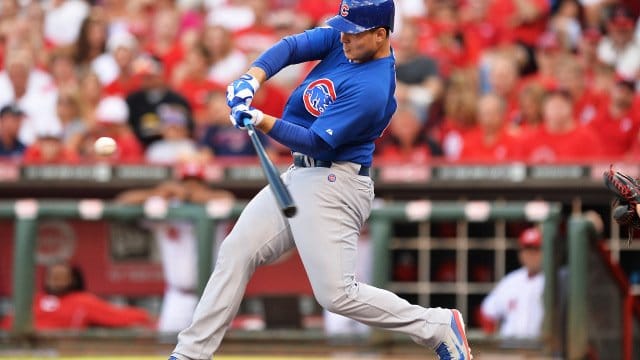
CINCINNATI, OH – JULY 9: Anthony Rizzo #44 of the Chicago Cubs hits a solo home run in the third inning against the Cincinnati Reds at Great American Ball Park on July 9, 2014 in Cincinnati, Ohio. (Photo by Jamie Sabau/Getty Images)
In this baseball batting cages strategy video, we answer the following reader question…
“I Have Several Young Hitters That Are Great In Baseball Batting Cages But Have Trouble Transitioning Those Techniques Into Game Situations. How Do I Teach That?”
We’ll go over:
- Over-coaching OR giving instruction during games,
- Promoting focused quality OR unfocused quantity swings at practices, and
- Training timing, plate discipline, and pitch recognition.
PLEASE NOTE: this is a complex issue, and to do the subject any justice, a 30-minute video and 4,000+ word post would suffice. However, I don’t have that time after adding a newly minted baby girl to our family.
So, I urge coaches to PLEASE contribute your comments at the end of this post, in the “Comments” section, of any other factors and/or fixes that I may have missed you think contribute to a successful transition from baseball batting cages (including softball coaches) to game at-bats. Many THANKS in advance!
Without further adieu, I’m going to hit the BIG three I think are the primary causes to the above coach’s challenge…
SCIENCE-BASED TRAINING:
Improve your hitting strategy dramatically by applying human movement principles.
Learn not only how and what to train but also the science behind the methods.
Over-Coaching OR Giving Instruction During Games
CLICK HERE to read this HPL post on what every coach needs to know about giving feedback to hitters.
From the Positive Coaching Alliance (PCA) website…
Mike Brey, the head Notre Dame men’s basketball coach, says ‘don’t coach every dribble’ in the following video:
3 things Coach Brey brings up about how to give feedback:
- Talk about something they did good,
- Then bring up some of the mistakes they made, and end with…
- Highlighting something they did good, again.
I call this tactic the constructive feedback sandwich.
Coach Tony LaRussa mentions, in his book One Last Strike, the ‘Pat & Pop’ Method of giving feedback to his players. The ‘Pat’ is the pat on the back (what they’re doing right), and the ‘Pop’ is the pop in the mouth (calling attention to the mistakes they made).
Men’s Notre Dame basketball Coach Mike Brey also mentions the WORST thing you can do is have a player looking at the “bench” after every play…or the dugout…or down the third base line.
Legendary baseball coach at Fresno State, Bob Bennett, who was my coach for three years, would sit in his chair at the clubhouse end of the dugout during games, with one leg crossed over the other, taking notes the whole game. He would rarely offer mechanical changes to players.
He just let us compete. During games, Coach Bennett focused his time on making situational game decisions.
It was at practice the notes he took during games – of the mistakes we made – would come to life. CLICK HERE for an audio interview I did with Coach Bennett over lunch.
So ask yourself the following question,
If you feel your players (or hitters) aren’t transitioning their swing from the baseball batting cages to game at-bats…
Are you over-coaching (‘coaching EVERY dribble), and/or giving instruction during games?
YES/NO?
Promoting Focused Quality OR Unfocused Quantity Swings at Practice
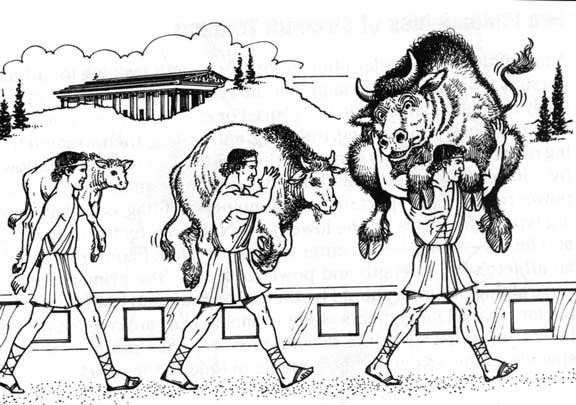
Milo of Croton’s body had to adapt (get stronger) to the demands put on it by the growing bull. Photo courtesy: miloandthecalf.com
Training MUST fit the sport’s objective.
In weight training, this is called the Principle of Specificity. Specificity according to FitStar.com:
“Specificity is the principle of training that states what you do in the gym should be relevant and appropriate to your desired outcome.”
During a baseball or softball game, a pitch is thrown once every 10-20 seconds.
A hitter may see THREE strikes in an at-bat, and may accumulate FOUR at-bats per game, so they may see TWELVE good pitches to swing at per game.
True, not all strikes are in the strike zone at the lower levels, but my point is, swing opportunities are lower in games.
So, am I saying to ration out swings to hitters at practice?
No, not at all.
I’m suggesting a change in coaching paradigm.
What I’m saying is, swings in baseball batting cages MUST be trained with focused quality, not with unfocused quantity.
Baseball batting cages training MUST prioritize the following:
- Plate discipline FIRST (are we swinging at strikes, YES/NO?),
- Timing SECOND (are we on time, YES/NO?), and
- Mechanics THIRD (are we swinging effectively, YES/NO?)
After each five swing round, I ask my hitters these three questions…and it’s rare that I get a hitter regressing after 3-5 rounds of focused quality hacks. Training MUST be more challenging (and frustrating), than game at-bats.
In games, hitters MUST NOT worry about mechanics, just make sure they’re swinging at strikes and getting on-time. Competing. Mechanics are for working on at practice or outside of game AB’s.
Free swinging batting practice, although fun as heck, does NOTHING for producing quality game at-bats.
What mechanics are considered effective versus ineffective?
CLICK HERE for a post I did answering that, in addition to how to get hitters buying into this system.
What’s an example of a baseball batting cages drill that is ineffective training for game at-bats?
Rapid fire soft toss.
WHY?
Because a hitter NEVER has to swing like this in a game!
Please go revisit the definition of the Principle of Specificity above.
The coaching rebuttal to the Rapid Fire Soft Toss Drill is, “But we’re working on quick hands”.
Okay, so if the objective of a pitcher was to throw three balls one after the other in quick succession, then rapid fire soft toss would work.
However, this isn’t how pitches are thrown in games work…
Pitchers throw one pitch every 10-20 seconds. Not three pitches every 10-20 seconds.
Game swings are NOT about quick hands. They’re about timing. One of the pitcher’s objective is to disrupt this. If a hitter is behind…they’re late…and THEIR TIMING IS OFF!!
In other words, it may not be a mechanical issue.
Please stay far away from this drill…
Sure, their hands or bat speed may be slow because of something like bat drag, but I’m here to tell you that the Rapid Fire Soft Toss Drill WILL NEVER help bat drag. This coach would be throwing gasoline on a fire, mechanically.
This is why fixing ineffective hitting mechanics add more reaction time to a hitter, because when a hitter moves better, they perform better.
Effectiveness is doing the right things, and efficiency is doing those things right.
Look, coaches have to understand the principles before coming up with the methods for fixing. Ralph Waldo Emerson said this about principles:
“The man who grasps principles can successfully select his own methods. The man who tries methods, ignoring principles, is sure to have trouble.”
Remember, our hitting objective priorities are:
- Plate discipline,
- Timing, and then
- Mechanics.
A hitter’s mechanics may be clean, but NOT swinging at strikes and NOT being on time WILL cause a mechanical breakdown…no matter how clean the mechanics.
So ask yourself the following question,
If you feel your players (or hitters) aren’t transitioning their swing from the baseball batting cages to game at-bats…
In baseball batting cages are you promoting focused quality OR unfocused quantity swings?
YES/NO?
Which leads me to the topics of…
Training Timing, Plate Discipline, and Pitch Recognition
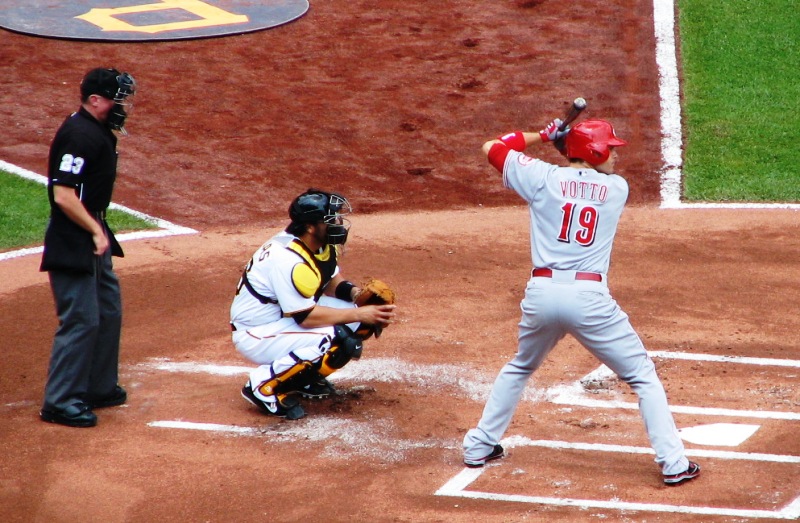
Joey Votto is one of the best with plate discipline. Photo courtesy of Red-Hot-Mama.com
In this section, I have a lot of HPL resources for you, instead of trying to reinvent the wheel here…
TIMING
- Fastpitch Softball Hitting Tips: Confidently Dominate Pitchers That Throw Heat
- Batting Timing Drills: 2 Little Known Ways To Get On Time
- Batting Baseball: Discover 4 Secrets To Tracking & Timing
- Brandon Moss REVEALS Slow Pitcher Timing Secret
- Josh Hamilton Video: Coaches Don’t Tell You This
- Fastpitch Softball Hitting Mechanics: Different Than Baseball? How?
PLATE DISCIPLINE
The post above is more advanced and is what I learned from Fresno State head baseball coach Mike Batesole my senior year in 2003. Btw, he was the head coach at Fresno State when the Bulldogs won the College World Series in 2008.
However, I recommend the strategy mentioned in the Matt Holliday link to the college level on up. High School coaches can experiment with it, typically when facing higher functioning pitchers. The challenge with it is that most pitchers at the lower levels aren’t as skilled at consistently placing pitches where they want them.
So, my recommendation for the lower levels is to focus on whether they swinging at strikes or not. Make it simple. Talk about the strike zone. What’s a good pitch to hit and what is not.
PITCH RECOGNITION
- Effective Velocity: Perry Husband Talks About How To Get 100% On Time & 100% Swing Efficient
- Baseball Vision Training That Bryce Harper Is Talking About
- Pitch Recognition Secrets Discovered: Dr. Peter Fadde Interview
- Mike Trout Video: Why Consistency Won’t Improve
So ask yourself the following question,
If you feel your players (or hitters) aren’t transitioning their swing from the baseball batting cages to game at-bats…
In baseball batting cages are you training timing, plate discipline, and pitch recognition?
YES/NO?
Coaches, PLEASE contribute anything I may have missed in regard to factors and/or fixes you feel contribute to a successful transition from baseball batting cages (including softball) to game at-bats.
Again, MANY thanks in advance!



